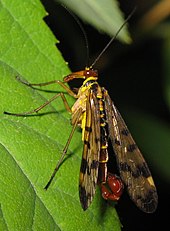Holometabola
| Holometabola Temporal range:Molecular clock indicates a possibleMississippianorigin[1]
| |
|---|---|

| |
| Panorpa communis,ascorpionfly(order Mecoptera) | |
| Scientific classification | |
| Domain: | Eukaryota |
| Kingdom: | Animalia |
| Phylum: | Arthropoda |
| Class: | Insecta |
| (unranked): | Eumetabola |
| (unranked): | Holometabola Burmeister,1835 |
| Orders | |
|
See text | |
| Synonyms | |
|
EndopterygotaSharp,1898 | |
Holometabola(fromAncient Greekholo-"complete" +metabolḗ"change" ), also known asEndopterygota(fromendo-"inner" +ptéryg-"wing" +Neo-Latin-ota"-having" ), is asuperorderofinsectswithin the infraclassNeopterathat go through distinctivelarval,pupal,and adult stages. They undergo a radicalmetamorphosis,with thelarvaland adult stages differing considerably in their structure and behaviour. This is calledholometabolism,or complete metamorphism.
Evolution[edit]
The Holometabola constitute the most diverse insect superorder, with over 1 million living species divided between 11orders,containing insects such asbutterflies,flies,fleas,bees,ants,andbeetles.[2]
The earliest holometabolanfossilsdate from theCarboniferous.[3]
The Holometabola are sometimes divided into three assemblages:Neuropterida(Neuroptera, Megaloptera, Raphidioptera, Strepsiptera and Coleoptera),Hymenopteroida(Hymenoptera), andPanorpida(Siphonaptera, Diptera, Trichoptera, Lepidoptera and Mecoptera).
Molecular analysis has clarified the group's phylogeny, as shown in the cladogram.[4]
| Holometabola |
| ||||||||||||||||||||||||||||||||||||||||||||||||||||||||||||
| (Endopterygota) |
Description[edit]

The Endopterygota are distinguished from theExopterygotaby the way in which their wings develop. Endopterygota (literally "internal winged forms" ) develop wings inside the body and undergo an elaborate metamorphosis involving a pupal stage. Exopterygota ( "external winged forms" ) develop wings on the outside their bodies and do not go through a pupal stage. The latter trait isplesiomorphic,however, as it is found also in groups such asOdonata(dragonflies and damselflies), which are not Neoptera, but morebasalamong insects.
See also[edit]
References[edit]
- ^Wang, Y.-h. et al. Fossil record of stem groups employed in evaluating the chronogram of insects (Arthropoda: Hexapoda). Sci. Rep. 6, 38939;doi:10.1038/srep38939(2016).
- ^Rolf G. Beutel; Hans Pohl (2006)."Endopterygote systematics – where do we stand and what is the goal (Hexapoda, Arthropoda)?".Systematic Entomology.31(2): 202–219.doi:10.1111/j.1365-3113.2006.00341.x.S2CID83714402.
- ^A. Nel; P. Roques; P. Nel; J. Prokop; J. S. Steyer (2007). "The earliest holometabolous insect from the Carboniferous: a" crucial "innovation with delayed success (Insecta Protomeropina Protomeropidae)".Annales de la Société Entomologique de France.43(3): 349–355.doi:10.1080/00379271.2007.10697531.S2CID86235521.
- ^Kjer, Karl M.;Simon, Chris;Yavorskaya, Margarita & Beutel, Rolf G. (2016)."Progress, pitfalls and parallel universes: a history of insect phylogenetics".Journal of the Royal Society Interface.13(121): 121.doi:10.1098/rsif.2016.0363.PMC5014063.PMID27558853.



